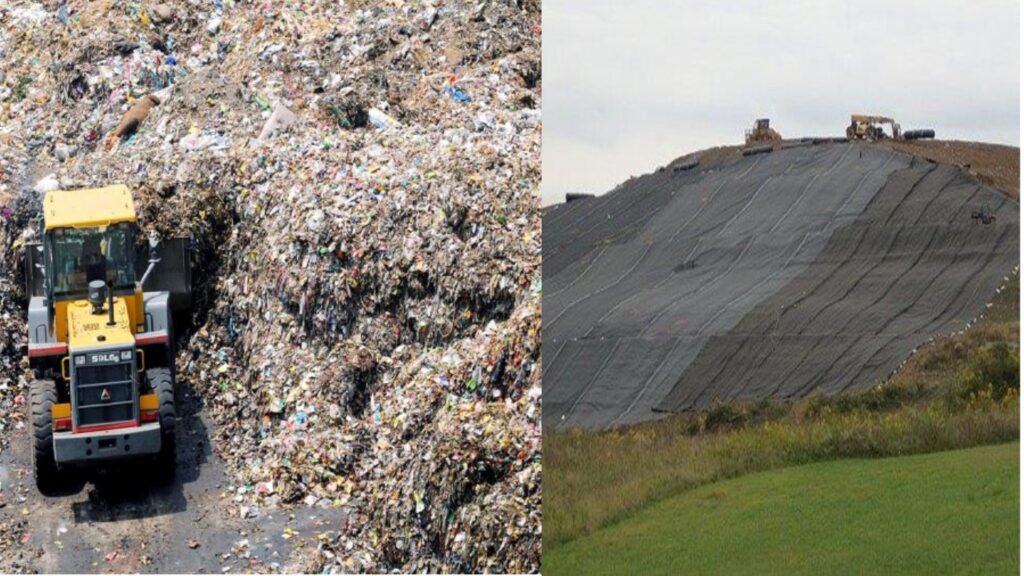
COMPETITIVE EXAM MCQs SERIES of ENVIRONMENTAL SCIENCE for UGC-NET/JRF, SLET, ARS, GATE, and other entrance tests – Disposal of Solid and Hazardous Wastes.
Syllabus Outline
- Contemporary techniques for waste treatment, recycling, and resource recovery.
- Landfill design & operation and incineration processes.
- Recent treatment technologies such as composting, anaerobic digestion, and pyrolysis.
- Environmental and health impacts of waste disposal.
- Regulatory frameworks and policies governing waste management.
This quiz contains the concept-based most frequently asked 25 MCQs of “Disposal of Solid and Hazardous Wastes“. Each question has a single correct/most appropriate answer.
*****
1. A secure landfill must have a minimum of _______ height separating the landfill base from underlying bedrock or a groundwater aquifer.
a) 5 m
b) 2 m
c) 3 m
d) 4 m
2. Underground injection of waste must be carried out at least ______away from an underground source of drinking water.
a) 400 m
b) 400 km
c) 40 km
d) 40 m
3. A long mound or stack of organic solid waste mixed with cattle dung and human excreta dumped on land is called:
a) Windrow
b) Secure landfill
c) Biomethanation
d) Pitchfork
4. Which method is most common in India to manage the solid waste collected from urban areas?
a) Land-filling
b) Incineration
c) Composting
d) Recycling and resource recovery
5. Which option is unsuitable for managing Construction and Demolition wastes?
a) Source Reduction
b) Composting
c) Recycling
d) Landfilling
6. Leachate recirculation in landfills aims to:
a) Increase waste biodegradation rate.
b) Reduce moisture content in the waste mass.
c) Enhance landfill stability and gas production.
d) Minimize the volume of landfilled waste.
7. What average percentage of the waste generated in India can be converted into compost?
a) 10%
b) 50%
c) 75%
d) 90%
8. Which of the following methods is considered most effective for reducing the long-term environmental impact of hazardous waste?
a) Incineration
b) Deep-well injection
c) Stabilization/Solidification
d) Landfilling
9. Which of the following is a critical factor in the design of a landfill liner system?
a) Permeability
b) Thickness
c) Chemical resistance
d) All of the above
10. What is the purpose of thermal desorption in hazardous waste management?
a) Reduce the volume of waste
b) Extract contaminants from waste using heat
c) Neutralize acidic waste
d) Encapsulate hazardous materials
11. Which of the following hazardous waste disposal methods involves impermeable geological formations?
a) Landfilling
b) Deep-well injection
c) Composting
d) Incineration
12. Stabilization/solidification processes are suitable for:
a) Organic liquids waste
b) Radioactive waste
c) Heavy metal-contaminated waste
d) Medical waste
13. Which international treaty aims to reduce the movement of hazardous waste between nations, especially from developed to less developed countries?
a) Montreal Protocol
b) Basel Convention
c) Kyoto Protocol
d) Stockholm Convention
14. The effectiveness of a landfill cap in preventing water infiltration is measured primarily by its:
a) Thickness
b) Permeability
c) Weight
d) All of the above
15. Which of the following is a significant concern related to the long-term storage of radioactive waste?
a) Biological degradation
b) Thermal instability
c) Radiation leakage
d) High flammability
16. The key difference between incineration and gasification of waste is:
a) Incineration requires higher temperatures than gasification
b) Gasification produces syngas, whereas incineration does not
c) Incineration generates more solid waste residues than gasification
d) Gasification emits more pollutants than incineration
17. Which process involves organic material’s thermal decomposition at elevated temperatures without oxygen?
a) Incineration
b) Gasification
c) Pyrolysis
d) Composting
18. In hazardous waste management, the purpose of using a geomembrane liner in a landfill is to:
a) Promote faster decomposition of waste
b) Enhance methane gas collection
c) Prevent the migration of contaminants
d) Facilitate the transport of waste
19. Which of the following is a common method for the disposal of asbestos-containing waste?
a) Incineration
b) Deep-well injection
c) Landfilling
d) Composting
20. Which hazardous waste treatment process is specifically designed to handle waste with high heavy metal content?
a) Anaerobic digestion
b) Phytoremediation
c) Stabilization/Solidification
d) Incineration
21. Which material is most commonly used as a daily cover for landfills to control odour and pests?
a) Plastic sheets
b) Soil
c) Geotextile fabric
d) Gravel
22. Which type of landfill is specifically designed to prevent the escape of hazardous waste contaminants into the environment?
a) Sanitary landfill
b) Secure landfill
c) Bioreactor landfill
d) Open dump
23. The term monofil refers to a landfill that:
a) Contains only one type of waste
b) Is designed for organic monomer waste
c) Is used for inert materials only
d) Uses a single-liner system
24. Which method is typically used to dispose of mercury-containing waste?
a) Incineration
b) Deep-well injection
c) Stabilization and landfilling
d) Composting
25. Which type of hazardous waste is commonly treated using vitrification?
a) Radioactive waste
b) Organic solvents
c) Heavy metals
d) Medical waste
*****
Previous: Electrical Energy from Solid Waste
Next: Hazardous Waste Management
References
- Freeman, H. M. (1998). Standard Handbook of Hazardous Waste Treatment and Disposal, McGraw-Hill, 2nd edition.
- Blackman, W. C. (2001). Basic Hazardous Waste Management, CRC Press, 3rd edition.
- Ramachandra, T. V. (2006). Management of Municipal Solid Waste, Capital Publishing Company.
- Rao, M. N. & Sultana, S. S. (2012). Solid and Hazardous Waste Management, BS Publications, 1st edition.

